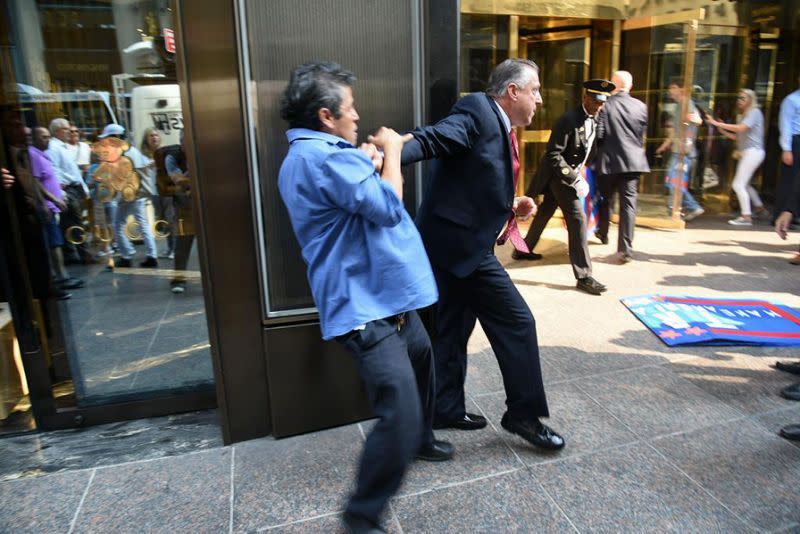Trump campaign violence goes back a long way
A series of ugly clashes at Trump campaign events over the past week have received widespread condemnation, and a defiant offer from the candidate himself to pay to defend a supporter who punched a protester who was being led away by security officers. Meanwhile, though, Donald Trump is defending himself against a lawsuit stemming from a confrontation between a demonstrator and the billionaire businessman’s chief bodyguard.
The fight played out on television when it occurred last September, but largely disappeared from the media radar screen afterwards. But the plaintiff’s lawyer told Yahoo News that he hopes to link it to the incidents at recent rallies to show a pattern of intimidation by the campaign’s security apparatus.
The lawyer, Benjamin Dictor, said Monday that his client, Efrain Galicia, is suing Trump, his campaign and his longtime security chief, Keith Schiller, over the fight on the sidewalk outside Trump’s signature New York skyscraper, Trump Tower.
As captured on video at the time, Schiller, a former New York City police officer who is now on Trump’s campaign payroll, punched Galicia in the face in a tussle over a sign that read “Trump: Make America Racist Again.”
Galicia and four other plaintiffs charge that this constituted “assault and battery” and a violation of their free speech rights. Without ruling on the underlying claims, a New York judge has already ruled that Schiller, whose title is director of security, “provoked” the incident, according to court papers reviewed by Yahoo News. Dictor said his clients are actively seeking evidence they believe will prove a broader point: that the Republican frontrunner has authorized his security personnel to routinely use force in dealing with political protests, as shown by the recent blowups at campaign rallies.

A Trump bodyguard with demonstrator Efrain Galicia, left, outside Trump Tower in New York last September. (Photo: Erik Pendzich/REX/Shutterstock)
“We’re right now in the middle of discovery, and all incidents of the use of force by Trump and his security are on the table,” Dictor said in a telephone interview.
Alan Garten, executive vice president and general counsel of the Trump Organization, called the lawsuit “baseless” and said the recent clashes at Trump campaign rallies were “irrelevant” because they took place after the incident.
As for the alleged assault, he said Schiller was acting in self-defense after Galicia “attacked him from behind” and “physically grabbed him” — possibly going for his gun — while Schiller was trying to peacefully re-enter the Trump headquarters.
“I’ve yet to see any evidence these individuals suffered any damages,” Garten added. “I’d love to know how they suffered.”
The incident dates back to the days after Trump announced his candidacy for presidency on June 16, 2015, declaring his intention to build a wall against “rapists” entering the country from Mexico. Galicia, who has been identified as a Mexican immigrant in news accounts, said in a court affidavit that he was “deeply offended” by the statements, leading him and his four fellow plaintiffs to demonstrate on the sidewalk outside Trump Tower on July 3, 2015, and again on Aug. 9, 2015. Although a Trump security guard initially told them it was “private property” and that they should leave, Galicia said he insisted he was on a public sidewalk, and a New York police officer allowed them to remain without incident.
But when the protesters returned with their signs on Sept. 3, they faced Trump security guards, who grabbed their signs and put them on the ground, according to Galicia’s affidavit. When Galicia attempted to set them back up, Schiller, the Trump security chief, “rushed towards me” and grabbed the signs, tearing one up and taking back the other one as he returned to the building.
Galicia says he rushed after Schiller to retrieve the sign and reached for it from behind. “As I reached for the sign, Schiller turned around and punched me in the head, knocking me backward,” Galicia claims. Video of the incident shows Galicia with his arm around Schiller’s waist, when Schiller turns and hits him. As Galicia falls backward, another man believed to be a Trump security guard grabs him in what the lawsuit alleges is a “chokehold.”
Garten, the Trump lawyer, said the security guards were well within their rights to remove the protest signs because they were blocking public access to Trump Tower. “They had created a barrier” to the building with the signs, he said. “They had created a dangerous situation. Nobody was trying to interfere with anybody’s First Amendment rights.”
But the plaintiffs have already won the first round in a court in the Bronx, where one of them lives. The judge in the case, Fernando Tapia, granted a preliminary injunction barring Trump and his security officials from blocking the demonstrators from protesting on the sidewalk outside the Trump Tower. In doing so, he concluded that it was Schiller, not Galicia, who was primarily at fault in the confrontation. While noting that there was a balance between the rights of a property owner and the rights of individuals to peacefully demonstrate, Tapia wrote on Oct. 8, that balance “was disrupted when Director of Security Schiller found it incumbent upon himself to approach the protesters and take their signs resulting in a confrontation, which, given the potentially volatile nature of the atmosphere, he provoked.”
What Schiller should have done, he continued, was consult with the New York Police Department — something he should have known given his 20 years of experience as a police officer.
“What’s more, through the conduct of their agents, defendants [Trump, the Trump for President Campaign and the Trump Organization as well as Schiller] have cast a ‘chilling pall’ over the plaintiffs’ fundamental rights to freely assemble and be heard,” Tapia concluded.


